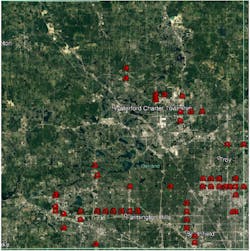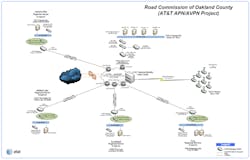Challenges in building and operating a traffic management center for a local government
The Road Commission for Oakland County, Michigan (RCOC) has been in the intelligent transportation systems (ITS) business since the inception of this field. RCOC serves Michigan’s second-most populous county, located just north and west of Detroit. At 900 sq miles and with more than 1.2 million people, Oakland County boasts the largest county road system in the state. RCOC has long been respected nationally among road agencies as a leader in innovation and technology. It was one of the first local road agencies to venture into the world of ITS in the early 1990s, establishing its adaptive traffic-signal system in 1992.
This system, known as Faster and Safer Travel through Traffic Routing & Advanced Controls (FAST-TRAC) started in the early 1990s with 28 signals in the city of Troy, Michigan, and has today grown to more than 825 signals, making it the second largest system of its kind in North America. Like many other transportation agencies, RCOC is also exploring the new, sophisticated, and complicated world of connected vehicles (CVs). Oakland County has one of the highest concentrations of ITS and CV technologies deployed by a local jurisdiction in the country, empowered by a long history of partnership with FHWA and the Michigan DOT. RCOC has effectively used partnerships to leverage scarce funds and remain involved in the latest technology advancements, which has kept RCOC on the leading edge of the CV conversation. Multiple successful public-private partnerships are also key for constant involvement in this field, e.g., Econolite for overhead detection, AT&T for communications, OEMs, Tier 1 suppliers, research agencies, and national and local traffic dissemination services.
RCOC was also one of the first local road agencies in the nation to establish a traffic operations center (TOC). More than 25 years later the agency has rebuilt its TOC several times, each time upgrading to the latest technologies. Additionally, the agency was one of the first to initiate the testing of ITS technologies and applications on local roads. RCOC’s ITS staff has become adept at managing and attaining funds as well as selecting technologies to maximize the effectiveness of those funds. Over the years, RCOC has maintained the same core signal operations software (SCATS) while updating the supporting tools regularly.
Where are we today?
Today, RCOC operates one of the largest communications systems in North America based on a cellular AVPN network. The agency maintains more than 2,000 I.P.-based devices reporting to its operations center. Additionally, RCOC has more than 100 local closed-circuit television (CCTV) cameras and access to more than 200 Michigan DOT freeway cameras.
The RCOC operations center has been through six updates, most recently a year ago. As one of the few agencies that has started to send detection camera video back to the operations center for more effective programming and planning, RCOC also has the ability to share its video resources with both external and internal customers. The agency also operates a real-time traffic website providing vital information to motorists.
RCOC has been a long-term partner with the FHWA and the state of Michigan in ITS initiatives. More recently, RCOC has partnered with the Oakland County general government (the Road Commission is an independent unit of government) in a cutting-edge connected-vehicle initiative. Agency staff are also involved in multiple national and state connected-vehicle forums representing RCOC.
Most recently, RCOC updated all hardware and software at its TOC, turning it into a state-of-the-art facility.
SCATS, CCTV & AT&T
There have been several studies performed on the operational and safety benefits of the FAST-TRAC system. Some of the core benefits have been found to be travel-time reductions of 20% during morning peak travel times; a 32% reduction in off-peak travel times; and a 7% reduction during the evening peak period. There has been an over 50% reduction in severe traffic crashes, and benefits such as real-time control of traffic signals and resolution of citizen concerns in a quick and efficient manner have encouraged public buy-in. Moreover, more efficient traveler information via the website has encouraged the public to utilize the system benefits. Engineers can maintain the system from the office, which makes troubleshooting and problem-solving much easier than going to the field for such tasks.
Over 110 local CCTV cameras are reporting to the operations center, facilitating everyday operations. The accumulated camera-based data is further aided by access to over 250 MDOT freeway cameras for southeastern Michigan freeways. Overall, the camera network has helped RCOC create new partnerships with state and local governments by sharing resources.
AT&T has partnered with RCOC since the inception of SCATS. After a detailed review, RCOC recently heavily reinvested into upgrading the communications to its traffic signals. Today there are more than 2,000 IP devices reporting to the new system. All this information is coming back to the TOC for more efficient operations. This public-private partnership has worked well for both sides and has been a real success story of collaboration.
Lessons learned and conclusions
Over the course of the development and implementation of the RCOC traffic operations and management system, those involved have gleaned much in the way of lessons learned as the system has grown. Among them are:
- It is important to test new technologies to an extent and then focus on the successful ones.
- Deploying proven concepts means starting very small and then, as time goes on, consolidating on successes and moving forward with a focused approach. This is one of the key factors for successful deployment of ITS operations.
- Drivers in Oakland County expect real-time information and a very fast resolution to any concerns they have. The RCOC website and its easy access from a mobile phone have addressed some of these challenges.
- Train and retain qualified personnel; retaining good talent is a challenge.
- As an agency RCOC has learned to be prepared to test multiple technologies and to expect that only a few will materialize for permanent field installations.
- Adaptive signals bring significant value to the table in terms of superior operations for internal and external customers.
- Communications upgrades bring options to expand the system and support future growth.
- The anticipated operational cost for communications maintenance is much lower than the current system and frees cash to perform other maintenance and/or new capital improvements.
- The upgrade also established a greater level of security for critical systems that need to be sheltered from public view and route through the AT&T network.
- With the deployment of leased 4G cellular services, the system will be able to achieve a high level of bandwidth to support multiple applications from a single traffic signal.
- An upgraded communication system will provide RCOC improved adaptive signal system efficiencies including reduced system downtime and improve user delay cost on the roadway.
- Currently, the focus is on upgrading detection, which is a never-ending endeavor. As technologies change, we have to adapt. Have extensive testing and deployment experience with loops, cameras, radar, and sensys systems.
- It will help to have support partnerships with internal and external stakeholders including first responders, neighboring counties, and MDOT to provide real-time camera feeds when responding to incidents.
- The deployment provides RCOC enhanced virtual security for the entire system.
- Staff can maintain systems from the office and make changes remotely to use their time efficiently.
- Open-door policy for testing and deployment. Easier said than done, need to have a buy-in from management.
- Agencies should always be looking to innovate and evolve. Self-analysis and figuring out ways to better processes and operations are now built into the RCOC’s work culture.




